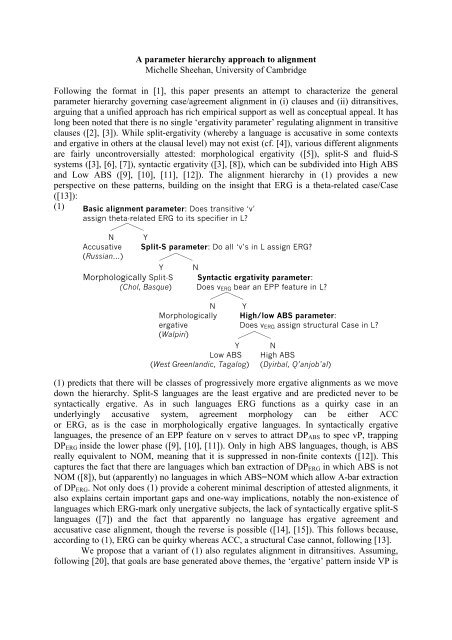Practical Information - Generative Linguistics in the Old World
Practical Information - Generative Linguistics in the Old World
Practical Information - Generative Linguistics in the Old World
You also want an ePaper? Increase the reach of your titles
YUMPU automatically turns print PDFs into web optimized ePapers that Google loves.
A parameter hierarchy approach to alignmentMichelle Sheehan, University of CambridgeFollow<strong>in</strong>g <strong>the</strong> format <strong>in</strong> [1], this paper presents an attempt to characterize <strong>the</strong> generalparameter hierarchy govern<strong>in</strong>g case/agreement alignment <strong>in</strong> (i) clauses and (ii) ditransitives,argu<strong>in</strong>g that a unified approach has rich empirical support as well as conceptual appeal. It haslong been noted that <strong>the</strong>re is no s<strong>in</strong>gle ‘ergativity parameter’ regulat<strong>in</strong>g alignment <strong>in</strong> transitiveclauses ([2], [3]). While split-ergativity (whereby a language is accusative <strong>in</strong> some contextsand ergative <strong>in</strong> o<strong>the</strong>rs at <strong>the</strong> clausal level) may not exist (cf. [4]), various different alignmentsare fairly uncontroversially attested: morphological ergativity ([5]), split-S and fluid-Ssystems ([3], [6], [7]), syntactic ergativity ([3], [8]), which can be subdivided <strong>in</strong>to High ABSand Low ABS ([9], [10], [11], [12]). The alignment hierarchy <strong>in</strong> (1) provides a newperspective on <strong>the</strong>se patterns, build<strong>in</strong>g on <strong>the</strong> <strong>in</strong>sight that ERG is a <strong>the</strong>ta-related case/Case([13]):(1) Basic alignment parameter: Does transitive ‘v’assign <strong>the</strong>ta-related ERG to its specifier <strong>in</strong> L?3N YAccusative Split-S parameter: Do all ‘v’s <strong>in</strong> L assign ERG?(Russian…) 3Y NMorphologically Split-S Syntactic ergativity parameter:(Chol, Basque) Does v ERG bear an EPP feature <strong>in</strong> L?3N YMorphologically High/low ABS parameter:ergative Does v ERG assign structural Case <strong>in</strong> L?(Walpiri) 3Y NLow ABS High ABS(West Greenlandic, Tagalog) (Dyirbal, Q’anjob’al)(1) predicts that <strong>the</strong>re will be classes of progressively more ergative alignments as we movedown <strong>the</strong> hierarchy. Split-S languages are <strong>the</strong> least ergative and are predicted never to besyntactically ergative. As <strong>in</strong> such languages ERG functions as a quirky case <strong>in</strong> anunderly<strong>in</strong>gly accusative system, agreement morphology can be ei<strong>the</strong>r ACCor ERG, as is <strong>the</strong> case <strong>in</strong> morphologically ergative languages. In syntactically ergativelanguages, <strong>the</strong> presence of an EPP feature on v serves to attract DP ABS to spec vP, trapp<strong>in</strong>gDP ERG <strong>in</strong>side <strong>the</strong> lower phase ([9], [10], [11]). Only <strong>in</strong> high ABS languages, though, is ABSreally equivalent to NOM, mean<strong>in</strong>g that it is suppressed <strong>in</strong> non-f<strong>in</strong>ite contexts ([12]). Thiscaptures <strong>the</strong> fact that <strong>the</strong>re are languages which ban extraction of DP ERG <strong>in</strong> which ABS is notNOM ([8]), but (apparently) no languages <strong>in</strong> which ABS=NOM which allow A-bar extractionof DP ERG . Not only does (1) provide a coherent m<strong>in</strong>imal description of attested alignments, italso expla<strong>in</strong>s certa<strong>in</strong> important gaps and one-way implications, notably <strong>the</strong> non-existence oflanguages which ERG-mark only unergative subjects, <strong>the</strong> lack of syntactically ergative split-Slanguages ([7]) and <strong>the</strong> fact that apparently no language has ergative agreement andaccusative case alignment, though <strong>the</strong> reverse is possible ([14], [15]). This follows because,accord<strong>in</strong>g to (1), ERG can be quirky whereas ACC, a structural Case cannot, follow<strong>in</strong>g [13].We propose that a variant of (1) also regulates alignment <strong>in</strong> ditransitives. Assum<strong>in</strong>g,follow<strong>in</strong>g [20], that goals are base generated above <strong>the</strong>mes, <strong>the</strong> ‘ergative’ pattern <strong>in</strong>side VP is





